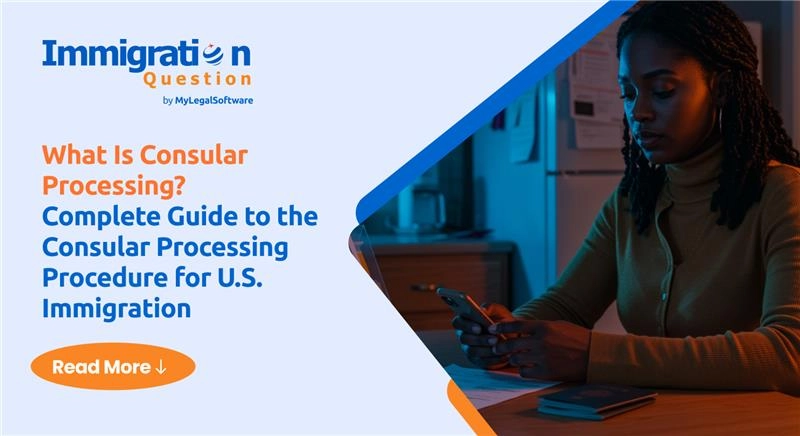If you’re living outside the United States and dreaming of becoming a lawful permanent resident, there’s a good chance you’ll go through something called consular processing. It’s one of the ways foreign nationals can apply for a U.S. immigrant visa while still abroad.
In this blog, we’ll break down exactly what the consular processing procedure involves, how long it might take, what fees to expect, and what happens during each step. Whether you’re applying based on family, employment, or even the diversity visa lottery, this guide will help you feel more prepared and less overwhelmed.
What Is Consular Processing?
Consular processing is the procedure by which someone outside the United States applies for an immigrant visa through a U.S. consulate or embassy. Unlike adjustment of status, which is for applicants already in the U.S., consular processing is designed for foreign nationals who are applying from abroad.
So, what does consular mean in this context? It refers to services provided by U.S. consulates, which are diplomatic offices outside the country that handle immigration matters.
The consular process is typically used in family-sponsored and employment-based immigration cases. Once the immigrant visa is approved, the applicant can travel to the U.S. and receive their green card shortly after arrival.
Wherever you are in the world, Immigration Question connects you with real immigration attorneys who can answer your questions—fast. No guesswork, no confusing forums—just clear, reliable guidance when you need it most. Start your path forward with confidence.
Who Needs to Go Through Consular Processing?
If you’re living outside the United States and you’ve been approved for an immigrant petition (like Form I-130 or I-140), you’ll most likely go through consular processing. Common applicants are:
- Spouses, children, or parents of U.S. citizens
- Employment-based visa applicants
- Diversity Visa (DV) lottery winners
In these cases, the consular processing procedure is the final step before lawful permanent residency.
Consular Processing Procedure: Step-by-Step Breakdown
Here are the major consular processing steps you’ll follow:
- Petition Approval – First, a U.S. citizen, lawful permanent resident, or employer files a petition with USCIS.
- Case Transfer to the National Visa Center (NVC) – After approval, USCIS sends the case to the NVC, which assigns a case number.
- Submit Fees and Documents – You’ll pay consular processing fees and submit civil and financial documents through the Consular Electronic Application Center (CEAC).
- Schedule the Interview – Once the NVC completes the document review, it schedules an interview at the appropriate U.S. embassy or consulate.
- Medical Exam – Before the interview, you must attend a medical examination with an authorized physician.
- Attend the Interview – You’ll be interviewed by a consular officer, who will review your documents and ask questions.
- Visa Decision – If approved, your passport will be returned with an immigrant visa. You can now travel to the U.S.
Consular Processing Timeline: How Long Does It Take?
The consular processing timeline varies based on your visa category, country of origin, and U.S. consulate workload.
On average, consular processing takes 6 to 12 months, but this can be shorter or longer depending on the situation. Some cases may be delayed due to missing documents or administrative processing.
Consular Processing Fees and Required Documents
Consular processing fees depend on your visa category. Typical costs include:
- Immigrant visa application fee: $325
- Affidavit of Support fee: $120
- Medical exam: Varies by country
You’ll also need to submit several documents, such as:
- Passport valid for at least 6 months beyond intended U.S. entry
- Birth certificate
- Police clearance certificates
- Affidavit of Support (Form I-864)
- Civil documents (marriage certificates, divorce decrees, etc.)
These documents are crucial to avoid delays, and they must be translated into English if needed.
What Happens After Visa Approval?
Once your immigrant visa is approved, you’ll receive a sealed visa packet and instructions for entering the U.S. You must arrive before the visa expiration date, typically 6 months after issuance.
After entering the U.S., your green card will be mailed to your U.S. address within a few weeks. You can begin working, studying, and living as a lawful permanent resident.
Final Thoughts
The consular process can feel overwhelming, but knowing each step can help reduce stress. From understanding the consular processing procedure to managing the consular processing timeline and fees, preparation is important.
If you’ve still got questions or just need a little extra help, visit Immigration Question to ask your questions and get professional advice. You’ll get answers from an immigration attorney within hours, and you may even get a free consultation.
Frequently Asked Questions
1. What is consular processing and how does it work?
Consular processing is how people outside the U.S. apply for an immigrant visa through a U.S. consulate or embassy. It includes submitting documents, paying fees, completing a medical exam, attending an interview, and receiving a visa to enter the U.S.
2. How long does it take for consular processing to be completed?
Consular processing typically takes 6 to 12 months, but can vary depending on your visa type, consulate backlog, and completeness of your application.
3. What are the steps in the consular processing procedure?
Steps include USCIS petition approval, case transfer to NVC, document submission, medical exam, visa interview, and final decision.
4. What are the consular processing fees and other costs?
Fees include a $325 visa application fee, $120 affidavit of support fee, and medical exam costs (varies). You may also need to pay for translations, courier services, and vaccinations.
5. Can I speed up the consular processing timeline?
Sometimes, yes. You can request expedited processing if you meet certain criteria, such as humanitarian need or urgent travel.
6. How do I know if consular processing is right for my case?
If you’re living abroad and applying for an immigrant visa, consular processing is likely your only option. It’s best to consult with an immigration attorney to confirm.





![Top 5 Immigration Questions People Asked Online This Week [May 30, 2025]](https://blog.immigrationquestion.com/wp-content/uploads/2025/05/top-5-immigration-questions-people-asked-online-this-week-may-30-2025-768x419.webp)



